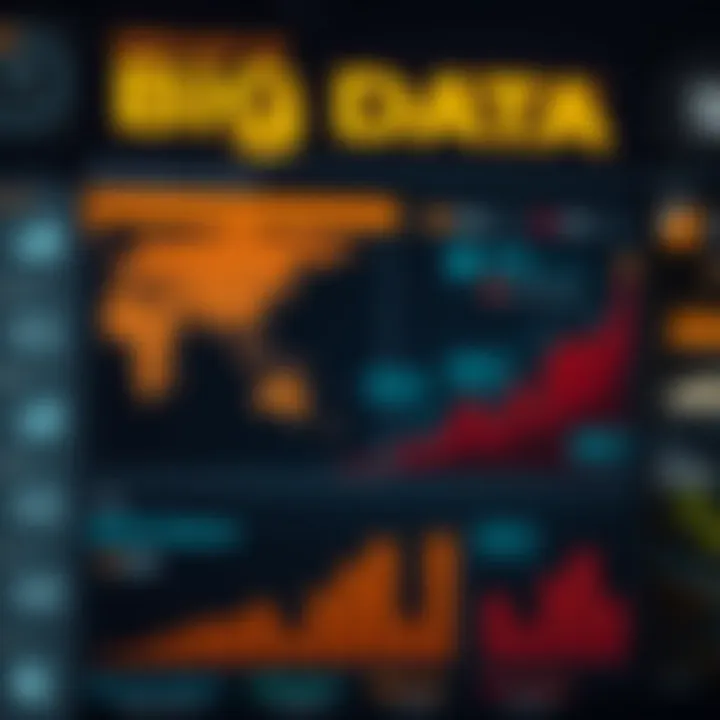Understanding Big Data: Size, Significance, and Impact


Intro
In today's fast-paced world, the sheer scale of data generated on a daily basis is staggering. As we embrace the digital era, understanding the enormity of data has never been more critical. This article navigates the multifaceted concept of big data, capturing its essence while defining its size and significance. The transformation from traditional data paradigms to big data is not merely a leap in volume but a complete shift in our approach to data processing and analysis.
Big data isn't just about vast amounts of information. It encompasses the characteristics that distinguish it from less formidable datasets. In this discourse, we will illuminate the key aspects that define big data, exploring the unique metrics that ascertain its magnitude—considering elements such as volume, velocity, variety, and variability. The relevance of this topic extends far beyond theoretical implications; it holds immense weight across various sectors, shaping how industries conduct business and make decisions.
Moreover, the technological advancements that enable the analysis of big data are pivotal. They not only determine how we comprehend this sophistication but also underscore its considerable impact on our economic landscapes. By the end of this article, a clearer perspective on the significance of big data and its integral role in modern society will be established, equipping readers with knowledge that is vital in today's data-driven environment.
Defining Big Data
Understanding the concept of big data is essential, as it serves as the backbone for myriad industries and disciplines today. Big data isn't just about having large sets of numbers; it's about recognizing the significance behind those numbers and what they can mean for organizations, innovation, and growth. By probing into how we define big data, we not only illuminate its characteristics but also assess the impact it has on decision-making and strategy planning.
In this discussion, we will take a closer look at various elements that form the crux of big data, scrutinizing aspects such as historical context, its key characteristics, and important size metrics. With this groundwork, we may glean insights about trends, patterns, and methodologies that are instrumental for harnessing the power of data effectively.
Historical Context
To fully grasp the magnitude of big data, it’s useful to contextualize it within its historical backdrop. The journey of data collection has seen a transformation from paper records and early computer databases to today’s advanced systems that collect and analyze vast quantities of data in real-time. In the 1960s, organizations began using mainframe computers to store and process data, which marked the first serious attempt at digital data management. Fast forward to the late 2000s and the advent of social media, smartphone usage, and the Internet of Things (IoT), and we find ourselves amid an explosion of information unlike anything seen before.
This evolution has seen industries adapting their methods, upgrading their technologies, and experimenting with analytics to stay relevant.
Key Characteristics
Big data is often distinguished by five key characteristics: volume, velocity, variety, veracity, and value. Each of these traits plays a crucial role in defining what constitutes big data and how it can be leveraged.
Volume
Volume refers to the sheer amount of data generated every minute of every day. The massive scale of data is not merely about the numbers; it’s about what can be done with this data. Think about the stories that can be unearthed from billions of transactions captured in retail or the insights gleaned from millions of health records. Its significance lies in the potential for making informed decisions. However, handling such vast quantities can present challenges such as storage issues and the need for more robust processing power.
Velocity
Velocity assesses the speed at which data is generated and must be processed. In today’s fast-paced world, businesses and organizations need to keep up with real-time data analysis to remain competitive. For instance, news updates, social media interactions, and stock market fluctuations need immediate attention. The primary challenge with velocity lies in ensuring timely analysis without compromising accuracy, leaving organizations to constantly adapt their strategies.
Variety
Variety pertains to the different types of data collected, ranging from structured data like databases to unstructured data, such as emails, images, or social media posts. Each type has its own intricacies and presents unique challenges in terms of data integration and analysis. The diverse formats lead to richer insights but also necessitate advanced technologies to properly structure and analyze the data.
Veracity
Veracity evaluates the accuracy and reliability of the data at hand. Not all data is created equal, and misinformation can lead organizations astray. The challenge here is filtering out noise to ensure the data being analyzed is trustworthy. In a world inundated with information, veracity becomes vital for sound decision-making.
Value
Value is the bottom line when it comes to data analysis. It’s not enough to collect data; it must be actionable. The insights derived from big data should push organizations toward better outcomes, whether that be increasing revenues, improving efficiency, or enhancing customer experiences. Companies must weigh the benefits against the costs associated with collecting and analyzing big data.
Data Size Metrics
An essential part of defining big data is understanding the varied metrics that help quantify its size. This involves looking beyond just bytes.
Bytes and Beyond
At its most basic level, data is measured in bytes. A byte is equivalent to a single character of text, and as data accumulates, it grows from kilobytes to megabytes, gigabytes, and so forth. In today’s world, we often speak in terms of petabytes and exabytes, emphasizing just how much data is being generated. This quantitative understanding of data helps organizations gauge their storage needs and define their analytical approaches accordingly.
Terabytes vs. Petabytes
When delving deeper, terabytes and petabytes represent substantial metrics in the big data realm. A terabyte consists of 1,024 gigabytes while a petabyte is 1,024 terabytes. The distinction is critical, especially for businesses facing exponential data growth, as it shapes their strategies on data management and usage.
Exabytes and Zettabytes
Exabytes and zettabytes take the data size discussion even further. One exabyte equals 1,024 petabytes, while a zettabyte stands at 1,024 exabytes. These metrics remind us of the future trajectory of data generation and highlight the necessity for scalable solutions in data analysis and storage.
Understanding how we define big data, its historical relevance and core characteristics serves not only as an educational exploration but also a necessity for financial enthusiasts and investors seeking to navigate an increasingly data-driven landscape.
The Importance of Context in Big Data


When speaking about big data, context is the unsung hero that can drastically enhance how we interpret the information we gather. Big data isn't just about having mountains of information; it's about leveraging that data effectively. Without context, raw data can be like a ship without a rudder, floating aimlessly without direction or purpose. In this section, we will dive into how the context surrounding big data is crucial for understanding its implications, especially when viewed through the lens of various industries.
Industry-Specific Thresholds
Every industry operates differently and the thresholds for what constitutes big data can vary significantly. Understanding these variances is essential to grasp how big data influences decision-making and strategy within specific sectors.
Retail
In the retail sector, the huge amounts of data generated—think point-of-sale systems, customer feedback, and inventory levels—help businesses understand purchasing patterns. This is particularly relevant during holiday seasons where consumer behavior shifts dramatically. The key characteristic here is customer personalization. Retailers analyze information to fine-tune their marketing efforts, making it a beneficial area for data analytics.
However, the unique feature of retail data is its seasonality. While high volumes of data are generated at peak times, off-peak periods can see a sharp decline in data activity. Thus, while big data provides insights, it can also pose the challenge of maintaining accuracy and relevance as trends fluctuate.
Healthcare
When it comes to healthcare, big data takes on a life of its own. The amount of data derived from electronic health records, clinical trials, and patient monitoring systems can be overwhelming. The key characteristic here is predictive analytics. Healthcare providers can utilize this information to anticipate patient needs and improve treatment modalities, making it a persuasive choice for this article's focus.
Nonetheless, healthcare data is often riddled with sensitivity and privacy issues. The unique feature here involves patient confidentiality, which adds an extra layer of complexity to analyzing data responsibly without breaching personal information.
Finance
In finance, data flow is continuous and involves transactions, market movements, and consumer behaviors. The essence of financial big data lies in its real-time analysis. This immediacy allows financial institutions to make quick decisions that can either benefit or harm their finances. A key aspect is that handling big data in finance can lead to better risk assessment and fraud detection.
However, the finance sector often has stringent regulations governing data usage, making compliance a major concern when applying big data analytics. The unique feature here is the need for cybersecurity, where sensitive financial data is a prime target for malicious entities.
Social Media
The realm of social media is a treasure trove of big data, where vast amounts of user-generated content are produced every second. The core aspect is user engagement analysis, where trends, sentiments, and behaviors can be decoded from posts, likes, and shares. This makes social media a popular domain for big data analysis, especially as platforms strive to understand and improve user experience.
A critical feature of social media data is its ephemeral nature. Trends can emerge and dissipate quickly, meaning that what’s relevant today could easily be forgotten tomorrow. As a result, companies need to be surprisingly nimble, adapting to the shifts in user behavior while keeping their big data strategies relevant.
Big Data vs. Small Data
Now, it’s important to differentiate between big data and small data. The contrast isn't just about size but about relevance and utility. Small data tends to be manageable, focused, and sometimes gives immediate insights. In contrast, big data, with its extensive volumes, may sometimes require advanced tools and strategies to make sense of it all.
Here’s a quick breakdown:
- Big Data: Large volumes, often unstructured, requires complex processing. Used for long-term insights.
- Small Data: Usually structured, easier to digest, and can often lead to quick decisions.
Understanding the context of both can inform the optimal strategy for data deployment in various industries, allowing businesses to maximize efficiency and effectiveness in their decision-making processes.
“Data without context is just noise. Knowing where to find meaning is what sets apart effective analysis.”
As we can see, the nuances attached to the context of big data are vital. These factors underscore the impact it has across varied domains, serving as a reminder that in the world of data, interpretation is everything.
Technologies Enabling Big Data Analysis
The world we live in today is inundated with data—every click, swipe, and interaction generates information. Thus, understanding how to analyze this sprawling mass of data is crucial. The technologies that enable the analysis of big data are fundamentally reshaping various industries, allowing businesses to drive insights from massive datasets, enhance operational efficiency, and ultimately improve decision-making processes. With the right technological framework, organizations can harness the power of big data to gain competitive advantages and innovate like never before.
Data Storage Solutions
Cloud Storage
Cloud storage has become the cornerstone of modern data solutions, enabling organizations to handle the vast amounts of information generated daily. The key characteristic of cloud storage is scalability; it allows businesses to increase or decrease storage capacity based on evolving needs without the hassle of physical infrastructure. This flexibility is particularly beneficial in fast-paced environments, where data volume can fluctuate rapidly.
A unique feature of cloud storage is its ability to facilitate collaboration across global teams. Documents and datasets can be accessed from anywhere, breaking down geographical barriers as long as there is internet access. However, there are disadvantages, such as data security concerns and potential outages that can disrupt operations. Nevertheless, for many companies, the benefits of cloud storage far outweigh the risks.
On-Premises Solutions
On-premises solutions, in contrast, refer to data storage systems located within the organization’s physical premises. These solutions offer a high degree of control over data, which can be particularly attractive in industries like finance and healthcare, where compliance with regulatory requirements is critical. A prominent characteristic of on-premises solutions is that they provide immediate access to data without reliance on internet connectivity.
However, setting up on-premises storage can be costly and time-consuming. The initial investment can be steep, along with ongoing maintenance costs. Companies may prefer this model if they prioritize security and control, but the inflexibility in scaling can be a downside in the long run.
Data Lakes vs. Data Warehouses


Data lakes and data warehouses serve distinct purposes, yet they are both essential in the big data landscape. A data lake is designed to store raw data in its native format until it’s needed, accommodating a vast array of data types, both structured and unstructured. The flexibility of data lakes makes them a popular choice for organizations interested in experimenting with big data and analytics.
On the other hand, data warehouses are more structured environments where data is cleaned, organized, and optimized for analysis. Businesses often choose data warehouses when they seek to perform complex queries and generate reliable reports.
Both data lakes and warehouses have their own advantages and disadvantages. While data lakes allow for easier storage of large volumes of diverse data, data warehouses give better performance for operational reporting and business intelligence. Choosing between them ultimately depends on an organization's specific needs and analytics goals.
Processing Frameworks
Hadoop
Hadoop has set a standard within the processing framework realm, allowing for the distributed processing of large datasets across clusters of computers. Its critical characteristic is its ability to manage huge volumes of data at relatively low costs due to its open-source nature. Hadoop’s unique feature is its Distributed File System (HDFS), which enables it to store data seamlessly and retrieve it for processing tasks.
However, while Hadoop is highly effective for batch processing, it can fall short in processing real-time data, which can be a hindrance in applications that require instant insights. Nonetheless, many organizations still rely on Hadoop due to its robustness and scalability.
Apache Spark
Apache Spark, often regarded as a more modern alternative to Hadoop, accelerates the processing of big data through in-memory computations. The key characteristic of Spark lies in its speed and efficiency, enabling faster data processing compared to traditional methods.
Spark is particularly beneficial due to its versatility; it can handle both batch and stream processing, which broadens the scope of its applications. Nevertheless, the resource demand of Apache Spark can be higher, which could impact organizations with limited computational resources.
Stream Processing
Stream processing plays a vital role in the ever-evolving big data landscape, allowing organizations to analyze data in real-time as it flows in. The core characteristic of stream processing is its capability to process data continuously, without the need for data collection and storage before analysis. This immediate insight can enhance decision-making and response times significantly.
The unique aspect of stream processing is found in its ability to act on high-velocity data—something traditional batch processing techniques might struggle with. The downside, however, is that it often requires more sophisticated technology to implement effectively.
"The technologies enabling big data analysis give businesses the tools they need to unravel insights that were once buried under heaps of data."
In summary, adopting the right technologies is crucial for any entity looking to harness the potential of big data. Whether it's choosing the most suitable storage solutions or the best processing frameworks, understanding the landscape creates a path toward effective data analytics.
Applications of Big Data
The field of big data constantly evolves, shaping industries and reinventing strategies. Understanding the applications of big data is vital. Organizations leverage big data to enhance efficiency, improve decision-making, and provide better products and services. The intrinsic value of analyzing colossal datasets lies in the ability to unearth patterns and trends that might otherwise go unnoticed. These insights fuel innovations and grant entities a competitive edge in the marketplace.
Big data applications can span across various domains, including business forecasting, enhancing customer experiences, and optimizing healthcare delivery. What’s imperative is recognizing that all data precision leads back to the context in which it’s used. Organizations need to focus on the practicalities of integrating big data seamlessly into their operations.
Predictive Analytics in Business
Predictive analytics emerges as a game-changer in the business sector. By harnessing historical data along with statistical algorithms and machine learning techniques, businesses can foresee trends, identify potential risks, and make more informed decisions. In essence, this approach transforms how companies interact with their market and customers.
For instance, consider how large retailers predict inventory needs. By analyzing past purchasing data, they determine the demand for products during specific seasons or events. This minimizes wastage and ensures that popular items remain in stock, significantly influencing profitability.
However, businesses must tread carefully. As they rely on predictive models, ensuring data accuracy and relevance is key. Failure to do so might lead to misguided strategies that can harm rather than aid growth.
Big Data in Healthcare
Big data significantly reframes healthcare. It streamlines patient care, enhances diagnosis accuracy, and pushes the boundaries of medical research. Below are two pivotal applications within this sector:
Patient Management
Patient management has seen a remarkable transformation due to big data. Hospitals and clinics utilize data analytics to understand patient histories better, track health patterns, and manage chronic diseases effectively. This enables clinicians to deliver more personalized treatment plans.
One specific characteristic of patient management is real-time monitoring. Wearable technology allows health professionals to collect data continuously, ensuring timely interventions. This feature significantly improves patient outcomes, as immediate data analysis can lead to swift physician responses.
Nonetheless, while this approach offers several advantages like reduced hospital readmission and timely treatment, it also presents challenges. Data privacy concerns loom large, posing threats ranging from unauthorized access to data breaches. Safeguarding sensitive patient information remains integral.
Research and Development
Another beneficial aspect of big data in healthcare is its profound impact on research and development. By analyzing vast amounts of clinical data, researchers can uncover new treatment methods and evaluate the effectiveness of existing ones. This capability not only accelerates the drug discovery process but also enhances clinical trials.
The unique feature here is data diversity. Data about patients’ demographics, treatment responses, and genetic information contribute to comprehensive understanding. However, multi-source data also complicates the analysis, as varying data standards and formats can lead to inconsistencies.
Through effective data management, these challenges can be tackled, enriching medical research further. By comprehending the intersections of these paths, the full perspective on big data's role in healthcare unfolds, illustrating its vital contributions toward innovation and improved patient care.


Impact on Consumer Behavior
Consumer behavior is increasingly influenced by big data applications. Companies tap into customer preferences, buying habits, and feedback to tailor their marketing strategies. Adapting to consumer demands becomes more than just a guessing game; it’s about informed predictions based on extensive analysis.
For example, online retailers utilize browsing history to offer personalized product recommendations. This approach not only boosts sales but enhances the overall customer experience.
That said, understanding consumer behavior through data also brings ethical considerations to the forefront. As businesses gather and analyze personal data, they must balance the drive for insights with respect for privacy. Building trust with consumers becomes essential in this data-driven landscape.
Challenges of Big Data Management
Managing big data is not a walk in the park, and understanding these challenges is essential for anyone diving into this field. The growth of big data brings along a set of hurdles that companies must navigate to leverage their data effectively. This section delves into these key challenges, spotlighting their implications and what they mean for businesses and individuals alike.
Data Privacy Concerns
In this digital age, data privacy looms large over any discussion involving big data. With the vast amounts of personal information being collected, concerns about how this data is used and protected are increasingly critical. It's not uncommon to hear horror stories about data breaches and unauthorized use of information, which can lead to severe consequences for both individuals and organizations.
When companies decide to harness big data for predictive analytics or customer insights, they must grapple with privacy regulations like GDPR or CCPA. These laws aim to protect consumer rights, but they can also complicate data collection efforts. Balancing the need for data with the obligation to protect individuals’ privacy is a delicate dance; failing to do so can tarnish a company's reputation or incur hefty fines. Organizations need to implement stringent data governance frameworks and ensure that their practices comply with applicable laws. Otherwise, they risk losing customer trust or even facing legal repercussions.
Quality and Accuracy of Data
“Garbage in, garbage out” is an adage that rings particularly true in the realm of big data. The sheer volume of information can easily lead to inaccuracies and inconsistencies if not carefully managed. Low-quality data can skew analysis results, leading companies to make misguided decisions based on faulty premises.
To prevent this from happening, organizations must invest in robust data quality measures. This means implementing automated data cleansing processes, employing skilled data analysts, and regularly auditing data sources to ensure their accuracy and reliability. Another critical element is establishing a clear data lineage, which refers to tracking the origins and evolution of the data. Understanding where data comes from can help identify potential quality issues, ensuring decisions are based on dependable information. Also, engaging in data enrichment strategies where additional context is added can bolster data accuracy significantly.
Skill Gaps in Data Science
Another pressing challenge in big data management is the noticeable skill gap in the field of data science. Even though demand for data professionals is on the rise, finding qualified individuals remains a tough nut to crack. Many organizations are left scratching their heads, unable to harness their data effectively due to a shortage of expertise.
The complexity of big data analytics requires a blend of technical skills and domain knowledge that not everyone possesses. Companies may find themselves wanting to deploy advanced analytics or machine learning but lack the talent capable of executing these sophisticated strategies. This often leads to missed opportunities or investments that yield poor returns. To tackle this issue, organizations might consider investing in continuous education for existing staff, collaborative programs with universities for talent sourcing, or strategic partnerships with specialized firms. Building a pipeline of skilled professionals equipped to meet these challenges will be pivotal for any entity wishing to navigate the big data landscape successfully.
In summary, while the potential of big data is immense, the hurdles it brings along are equally formidable. Addressing these challenges head-on is essential for harnessing the value of data effectively.
Future Perspectives on Big Data
The landscape of big data is constantly evolving, and understanding its future perspectives is crucial for appreciating its potential impact on various sectors. By illuminating the advancements brewing in the fields of artificial intelligence and quantum computing, we can gain a clearer view of how big data will shape decision-making processes and operational strategies moving forward. The benefits of harnessing these technologies not only streamline data analysis but also deepen insights, potentially leading to groundbreaking innovations across industries.
The Role of Artificial Intelligence
Artificial intelligence sits at the forefront of big data analysis, acting as a powerful ally in deciphering vast datasets. With the capability to learn and adapt, AI enhances the extraction of meaningful patterns from data that, when analyzed manually, would require countless hours or simply be unfeasible. Machine learning algorithms and natural language processing, for instance, are pivotal in detecting trends and foreseeing outcomes based on historical data.
In sectors like finance, engineers employ AI to predict stock market behaviors, enabling optimized investment strategies. Similarly, in retail, AI-driven analytics help tailor marketing campaigns to the preferences of individual consumers, maximizing engagement and sales.
When we talk about the scope of AI in big data, it's not merely conjecture anymore. Companies that leverage AI-backed analytics can gain a competitive edge, translating data into actionable insights faster than their peers. Moreover, as data generation surges, the AI tools designed to work with big data will also evolve, incorporating advanced techniques such as reinforcement learning.
"In the realm of big data, the marriage of AI creates a future where data-driven decisions reign supreme."
Quantum Computing and Big Data
As we peer into the future, quantum computing emerges as a game changer in the arena of big data analytics. Unlike traditional computing that relies on bits as the basic unit of data, quantum computers utilize qubits, which can represent and store information in multiple states at once. This fundamentally alters the speed and efficiency of data processing.
For instance, in scenarios that involve massive datasets—like genomic research or climate modeling—quantum computing can calculate probabilities with unparalleled speed. Tasks that might take classical computers years to perform could be accomplished in mere moments with quantum capabilities. This means that the potential for innovation is not just about getting results quicker but also about unlocking insights that were previously out of reach.
The implications are vast. Industries such as pharmaceuticals could significantly enhance their capabilities in drug discovery, while financial institutions might find themselves equipped to process transactions with greater security and speed.
As quantum technology continues to burgeon, it invites us to ponder a future where big data analysis transcends existing limitations, paving the way for extraordinary breakthroughs and possibly reforming sustainability efforts through highly intricate models.
In summary, the future of big data promises to be colorful and complex, with artificial intelligence and quantum computing as pivotal catalysts. Embracing these changes will not only ensure that we stay relevant but also empower us to transform ideas into impactful realities.
Culmination
In wrapping up our exploration of big data, it's essential to highlight how the significance of this field transcends mere technical specifications and dives into the practical ramifications for industries, organizations, and individuals alike. As we've discussed throughout this article, the scale of data we encounter today can be daunting, yet it wields transformative potential in both operational and strategic avenues.
First and foremost, understanding what constitutes big data not only provides clarity on data handling but also frames the decision-making processes within various sectors. For instance, companies in retail can harness the power of big data to optimize inventory management, tailor marketing efforts, and enhance customer insights. This ability to understand and act on vast datasets can lead to increased efficiency and higher profitability.
"In an era saturated with information, the ability to discern meaningful data from noise is more crucial than ever."
Moreover, the implications of big data extend into the realms of healthcare, finance, and consumer behavior. In healthcare, predictive analytics driven by extensive patient data can revolutionize patient outcomes and resource management. In finance, big data analytics can uncover trends and patterns that inform investment strategies, which is invaluable for individual investors looking to gain an edge in a competitive market.
As we stride into the future, the interplay between big data, technological advancements, and human expertise will define the landscape. The synergy between artificial intelligence and quantum computing is particularly promising. These technologies will enhance our capacity to analyze complex datasets at unprecedented speeds, ushering in a new wave of innovations and applications.















